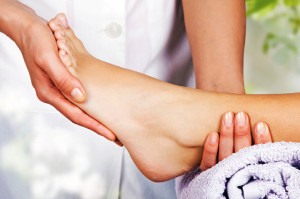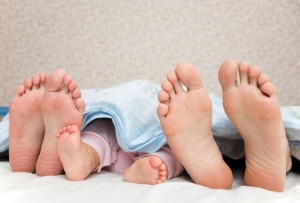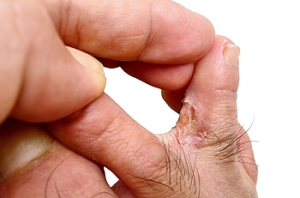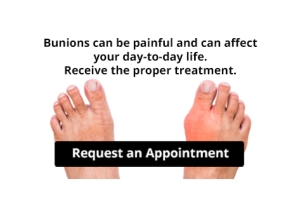Port Neches, TX (409) 727-1122

Foot Massages May Help to Reduce Anxiety
Foot massages have become increasingly popular, and research has indicated it may help to heal ailments in other parts of the body. When the toes are curled, and the portion of the foot is massaged under the ball of the foot, this may aid in reducing anxiety. Patients who are suffering from chronic pain in the body may find that rolling the sole of the foot on a tennis ball could bring mild relief. Lower back pain may be diminished when the pressure points in the arches are massaged, followed by firmly rubbing the entire sole of the foot. If you are diabetic, it is suggested that you seek the counsel of a podiatrist who can provide information about how nerves that are damaged can be affected by massaging.
Foot therapy is often necessary for those recovering from either foot deformities or foot injuries. If you have concerns regarding therapy, consult with Pete O’Donald, DPM from Texas. Our doctor can provide the care you need to keep you pain-free and on your feet.
Most Common Injuries
People who are active or athletes are prone to a variety of injuries. Therefore, it is often important to take part in physical therapy in order to quickly get back on the right track.
What to Do When Injured
Physical Therapy – This specialized treatment will focus on the affected area, speeding up recovery and the overall healing process. It is a proven method that has helped millions of people return from any injury.
During physical therapy you will undergo regimented training to get back into full form. Training is often very difficult, especially at first when the foot feels weak. Physical therapy often involves:
Basic stretching and twisting exercises – getting the feet’s mobility and flexibility up.
Massaging – the therapist will massage the injured area in order to activate the muscles and relax them.
Strengthening Exercises – this allows the muscles in the affected area to regain their full strength, a vital step towards full recovery.
If you have any questions please feel free to contact our office located in Nederland, TX . We offer the newest diagnostic tools and technology to treat your foot and ankle needs.
Foot Therapy for Sports Injuries
Whether in practice or in the game, athletes put their bodies through great stress. Some sports demand more from the body than others. However, every sport has an element of inorganic movement or unnatural motion. For example, in softball, a pitcher winds up and flings her body with an incredible amount of dexterity in order to get the most ideal velocity out of her pitches. This motion, incredibly taxing on the body, can cause serious injury.
One of the most common issues of athletic injuries happens in the feet. If it’s a damaging fracture that leaves the athlete sidelined or just a simple turf toe, foot injuries can still be very frustrating and painful. Regardless of the sport, athletes still require use of their feet in some fashion. This is why foot therapy is extremely vital for getting athletes back on the right track to return to the field.
No matter the injury, the best way to speed up the recovery period is to receive physical therapy. Physical therapy has proven to work for millions of people. Professional physical therapists are specifically trained to help people return to proper form from any injury.
During physical therapy, you will go through organized training in order to get back into form. Sometimes training can be quite difficult, especially in the beginning when there is more pain and the foot feels awkward. To alleviate this, you will do basic twisting and stretching exercises in order to get flexibility and foot mobility back up. The therapist will also massage the injured area to activate and relax muscles. Over time you will eventually move up to strengthening exercises, designed specifically so that the injured area is exercised.
Foot therapy for sports is a modern science miracle. Unlike other treatments that may employ the use of fancy chemicals and terminology, physical therapy is an evidence-based practice that offers the same benefits. Due to huge advancements in the knowledge of muscles and joints, doctors can turn catastrophic injuries around so that athletes can return to the game once more.
Foot Changes That Can Occur in Pregnancy
 There are numerous changes a woman’s body goes through while being pregnant. The feet are often affected, and obvious differences can be noticed. These can include swelling, chronic aching, and muscle cramps. It is helpful to buy shoes that fit correctly, and the best time to accomplish this is later in the day when the feet are at their largest. It is important to choose shoes that have adequate room for the toes to move freely in, as this can help to prevent unwanted foot conditions from developing. When the feet become swollen, many women find mild relief when the feet are elevated, in addition to performing gentle foot stretches. If you would like additional information on how to have your feet feel better during pregnancy, please consult with a podiatrist.
There are numerous changes a woman’s body goes through while being pregnant. The feet are often affected, and obvious differences can be noticed. These can include swelling, chronic aching, and muscle cramps. It is helpful to buy shoes that fit correctly, and the best time to accomplish this is later in the day when the feet are at their largest. It is important to choose shoes that have adequate room for the toes to move freely in, as this can help to prevent unwanted foot conditions from developing. When the feet become swollen, many women find mild relief when the feet are elevated, in addition to performing gentle foot stretches. If you would like additional information on how to have your feet feel better during pregnancy, please consult with a podiatrist.
Pregnant women with swollen feet can be treated with a variety of different methods that are readily available. For more information about other cures for swollen feet during pregnancy, consult with Pete O’Donald, DPM from Texas. Our doctor will attend to all of your foot and ankle needs.
What Foot Problems Can Arise During Pregnancy?
One problem that can occur is overpronation, which occurs when the arch of the foot flattens and tends to roll inward. This can cause pain and discomfort in your heels while you’re walking or even just standing up, trying to support your baby.
Another problem is edema, or swelling in the extremities. This often affects the feet during pregnancy but tends to occur in the later stages.
How Can I Keep My Feet Healthy During Pregnancy?
- Wearing orthotics can provide extra support for the feet and help distribute weight evenly
- Minimize the amount of time spent walking barefoot
- Wear shoes with good arch support
- Wear shoes that allow for good circulation to the feet
- Elevate feet if you experience swelling
- Massage your feet
- Get regular, light exercise, such as walking, to promote blood circulation to the feet
If you have any questions please feel free to contact our office located in Nederland, TX . We offer the newest diagnostic and treatment technologies for all your foot and ankle needs.
Foot Care for Pregnant Women
The natural weight that pregnant women gain causes their center of gravity to be completely altered. This causes them to have a new weight-bearing stance which adds pressure to the knees and feet. As a result, pregnant women often experience severe foot pain. The two most common foot issues experienced by women in their pregnancies are edema and over-pronation. It is important for all pregnant women to learn more about how to take care of their feet so they are more comfortable during their pregnancy.
Over-pronation, which is commonly referred to as flat feet, is caused when a person’s arch flattens out upon weight bearing. This causes the person’s feet to roll inward while walking. Pregnant women often experience this due to the sudden weight they gain.
Edema, also referred as swelling in the feet, typically occurs in the later part of the pregnancy. It is the result of the extra blood accumulated in the pregnant woman’s body. The enlarged uterus puts more pressure on the blood vessels in the pelvis which causes leg circulation to slow down. This causes blood to pool in the lower extremities.
Fortunately, there are ways to treat both edema and over-pronation. Edema can be treated by elevating the foot as often as possible. Wearing proper fitting footwear will also be helpful for those with edema. A treatment method for over-pronation could be orthotics. Orthotic inserts should be designed with appropriate arch support and medial rear foot for your foot.
It is best for pregnant women to buy new shoes during the day, because this is the time where swelling is at its peak. Pregnant women also shouldn’t rush when buying shoes. It is always advised that you make sure your shoes fit properly but this is especially important during pregnancy.
If you are a pregnant woman, you should consult with a podiatrist in order to make sure your feet are healthy throughout the entirety of your pregnancy.
Stretching Techniques for the Feet
 When the soles of the feet are stretched, it may contribute to an overall positive feeling in the body. The feet are considered to be the foundation of the body, and chronic foot pain may affect the way you walk. There are simple ways to stretch the arches, toes, and soles, and it is beneficial to practice these stretches as frequently as possible. An effective stretch begins with starting on your hands and knees, and gradually sitting back on your heels, while keeping the toes tucked. To stretch the toes and ankles, sit on the floor and cross one leg over the other. Grasp one foot, and gently pull the toes apart, while moving the ankle in circles. The arch can be stretched by rolling the foot on a tennis ball or frozen water bottle. The latter technique may feel good after a long day of standing on your feet. If you would like additional information about how to stretch your feet, please consult with a podiatrist.
When the soles of the feet are stretched, it may contribute to an overall positive feeling in the body. The feet are considered to be the foundation of the body, and chronic foot pain may affect the way you walk. There are simple ways to stretch the arches, toes, and soles, and it is beneficial to practice these stretches as frequently as possible. An effective stretch begins with starting on your hands and knees, and gradually sitting back on your heels, while keeping the toes tucked. To stretch the toes and ankles, sit on the floor and cross one leg over the other. Grasp one foot, and gently pull the toes apart, while moving the ankle in circles. The arch can be stretched by rolling the foot on a tennis ball or frozen water bottle. The latter technique may feel good after a long day of standing on your feet. If you would like additional information about how to stretch your feet, please consult with a podiatrist.
Stretching the feet is a great way to prevent injuries. If you have any concerns with your feet consult with Pete O’Donald, DPM from Texas. Our doctor will assess your condition and provide you with quality foot and ankle treatment.
Stretching the Feet
Being the backbone of the body, the feet carry your entire weight and can easily become overexerted, causing cramps and pain. As with any body part, stretching your feet can serve many benefits. From increasing flexibility to even providing some pain relief, be sure to give your feet a stretch from time to time. This is especially important for athletes or anyone performing aerobic exercises, but anyone experiencing foot pain or is on their feet constantly should also engage in this practice.
Great ways to stretch your feet:
- Crossing one leg over the others and carefully pull your toes back. Do 10-20 repetitions and repeat the process for each foot
- Face a wall with your arms out and hands flat against the wall. Step back with one foot and keep it flat on the floor while moving the other leg forward. Lean towards the wall until you feel a stretch. Hold for 30 seconds and perform 10 repetitions for each foot
- Be sure not to overextend or push your limbs too hard or you could risk pulling or straining your muscle
Individuals who tend to their feet by regular stretching every day should be able to minimize foot pain and prevent new problems from arising.
If you have any questions, please feel free to contact our office located in Nederland, TX . We offer the newest diagnostic and treatment technologies for all your foot care needs.
Babies and Flat Feet
 Research has indicated that most babies are born with flat feet, which will most likely change as they become older. This condition may persist in a limited amount of children, and there may be specific reasons for this. The Achilles tendon may be shortened, and this can result in the muscles and ligaments becoming tightened in the heel area. This can lead to reduced motion in the foot and may cause the arch of the foot to become flat. Children who have flat feet after walking begins may experience pain and discomfort in the place of the foot where the arch would normally be, and it may be difficult to move the foot up and down or side to side. If flat feet are left untreated, it can lead to serious foot conditions that may include arthritis. If you notice your child has flat feet while walking, it is suggested to consult with a podiatrist who can help you to find the correct treatment techniques.
Research has indicated that most babies are born with flat feet, which will most likely change as they become older. This condition may persist in a limited amount of children, and there may be specific reasons for this. The Achilles tendon may be shortened, and this can result in the muscles and ligaments becoming tightened in the heel area. This can lead to reduced motion in the foot and may cause the arch of the foot to become flat. Children who have flat feet after walking begins may experience pain and discomfort in the place of the foot where the arch would normally be, and it may be difficult to move the foot up and down or side to side. If flat feet are left untreated, it can lead to serious foot conditions that may include arthritis. If you notice your child has flat feet while walking, it is suggested to consult with a podiatrist who can help you to find the correct treatment techniques.
Making sure that your children maintain good foot health is very important as they grow. If you have any questions, contact Pete O’Donald, DPM of Texas. Our doctor can provide the care you need to keep you pain-free and on your feet.
Keeping Children's Feet Healthy
Having healthy feet during childhood can help prevent medical problems later in life, namely in the back and legs. As children grow, their feet require different types of care. Here are some things to consider...
Although babies do not walk yet, it is still very important to take care of their feet.
Avoid putting tight shoes or socks on his or her feet.
Allow the baby to stretch and kick his or her feet to feel comfortable.
As a toddler, kids are now on the move and begin to develop differently. At this age, toddlers are getting a feel for walking, so don’t be alarmed if your toddler is unsteady or ‘walks funny’.
As your child gets older, it is important to teach them how to take care of their feet.
Show them proper hygiene to prevent infections such as fungus.
Be watchful for any pain or injury.
Have all injuries checked by a doctor as soon as possible.
Comfortable, protective shoes should always be worn, especially at play.
If you have any questions please feel free to contact our office located in Nederland, TX . We offer the newest diagnostic and treatment technologies for all your foot and ankle needs.
Are Corns Painful?
 A corn on the foot will typically develop as a result of friction the foot endures. This can come from wearing shoes that do not fit correctly, not wearing socks, or performing repetitive actions, such as running and jogging. Corns can be quite painful, and there are several ways to find mild relief. Wearing socks may help to put a barrier between the shoe and the foot. Additionally, if the corn is caused by wearing poorly-fitting shoes, it is beneficial to properly measure your foot, which will help to determine the correct shoe size. There are patients who find comfort in applying a lotion to the affected area. This can be helpful in softening the skin, which may prevent the corn from cracking. If you are afflicted with a corn, it is advised to seek the counsel of a podiatrist, who can suggest the best treatment, and recommend preventive measures.
A corn on the foot will typically develop as a result of friction the foot endures. This can come from wearing shoes that do not fit correctly, not wearing socks, or performing repetitive actions, such as running and jogging. Corns can be quite painful, and there are several ways to find mild relief. Wearing socks may help to put a barrier between the shoe and the foot. Additionally, if the corn is caused by wearing poorly-fitting shoes, it is beneficial to properly measure your foot, which will help to determine the correct shoe size. There are patients who find comfort in applying a lotion to the affected area. This can be helpful in softening the skin, which may prevent the corn from cracking. If you are afflicted with a corn, it is advised to seek the counsel of a podiatrist, who can suggest the best treatment, and recommend preventive measures.
If you have any concerns regarding your feet and ankles, contact Pete O’Donald, DPM of Texas. Our doctor will treat your foot and ankle needs.
Corns: What Are They? and How Do You Get Rid of Them?
Corns can be described as areas of the skin that have thickened to the point of becoming painful or irritating. They are often layers and layers of the skin that have become dry and rough, and are normally smaller than calluses.
Ways to Prevent Corns
There are many ways to get rid of painful corns such as wearing:
- Well-fitting socks
- Comfortable shoes that are not tight around your foot
- Shoes that offer support
Treating Corns
Treatment of corns involves removing the dead skin that has built up in the specific area of the foot. Consult with Our doctor to determine the best treatment option for your case of corns.
If you have any questions please feel free to contact our office located in Nederland, TX . We offer the newest diagnostic and treatment technologies for all your foot and ankle needs.
How Do Foot Injuries Occur?
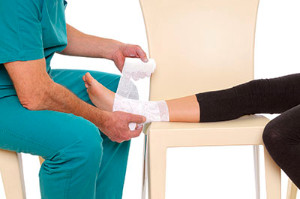 Stability in the foot is provided when the foot and ankle work together. There are injuries that can occur to the feet while participating in sporting activities. These can include issues with the Achilles tendon and ankle sprains. The former may produce pain in the back of the calf and heel area, in addition to swelling and stiffness. Additionally, there may be reduced strength, and limited range of motion. Ankle injuries may occur as a result of participating in high-impact activities. Many patients can sprain their ankle if they step off a curb unexpectedly and this can force the ankle to turn beyond its normal range of motion. This injury is typically treated by elevating the foot, which may be helpful in reducing any existing swelling. It is then followed by wrapping the affected ankle in a tight elastic bandage, which may provide the necessary stability as the healing process takes place. If you have injured your foot or ankle, it is strongly advised that you seek the counsel of a podiatrist.
Stability in the foot is provided when the foot and ankle work together. There are injuries that can occur to the feet while participating in sporting activities. These can include issues with the Achilles tendon and ankle sprains. The former may produce pain in the back of the calf and heel area, in addition to swelling and stiffness. Additionally, there may be reduced strength, and limited range of motion. Ankle injuries may occur as a result of participating in high-impact activities. Many patients can sprain their ankle if they step off a curb unexpectedly and this can force the ankle to turn beyond its normal range of motion. This injury is typically treated by elevating the foot, which may be helpful in reducing any existing swelling. It is then followed by wrapping the affected ankle in a tight elastic bandage, which may provide the necessary stability as the healing process takes place. If you have injured your foot or ankle, it is strongly advised that you seek the counsel of a podiatrist.
Foot and ankle trauma is common among athletes and the elderly. If you have concerns that you may have experienced trauma to the foot and ankle, consult with Pete O’Donald, DPM from Texas. Our doctor will assess your condition and provide you with quality foot and ankle treatment.
Foot and ankle trauma cover a range of injuries all over the foot; common injuries include:
- Broken bones
- Muscle strains
- Injuries to the tendons and ligaments
- Stress fractures
Symptoms
Symptoms of foot and ankle injuries vary depending on the injury, but more common ones include:
- Bruising
- Inflammation/ Swelling
- Pain
Diagnosis
To properly diagnose the exact type of injury, podiatrists will conduct a number of different tests. Some of these include sensation and visual tests, X-rays, and MRIs. Medical and family histories will also be taken into account.
Treatment
Once the injury has been diagnosed, the podiatrist can than offer the best treatment options for you. In less severe cases, rest and keeping pressure off the foot may be all that’s necessary. Orthotics, such as a specially made shoes, or immobilization devices, like splints or casts, may be deemed necessary. Finally, if the injury is severe enough, surgery may be necessary.
If you have any questions, please feel free to contact our office located in Nederland, TX . We offer the newest diagnostic and treatment technologies for all your foot care needs.





